Even without its beaches, Barcelona would be one of Europe’s coolest destinations thanks to its groundbreaking food scene, unique architecture and legendary nightlife.
But the cherry on the sundae is the three-mile strip of nearly continuous golden sand, which is so wired into its heart that it’s like the entire city’s backyard.
Much of the seafront buzzes with a carnival atmosphere year-round, with hawkers tiptoeing around sunbathers to sell cold cans of beer, beach blankets and chintzy trinkets.
Along the pedestrian promenade that runs the length of the waterfront, musicians, street performers and sand sculptors compete for tips among a constant stream of strolling tourists and locals to this part of Spain.
Weaving around them are bikes, Segways, skateboards, motorized scooters, rickshaws, rollerbladers and every other wheeled contraption imaginable.
The most popular beaches are only a 15-minute walk from the tangled alleys of Barcelona’s oldest area, and the quieter ones to the north are easily accessible by public transit.
Meanwhile, there’s something for every type of beachgoer, from the partying weekender to the family man to the bronzed sunbather looking to relax with a book.
Here’s your guide on how to find your kind of beach in the capital of Catalonia:
Barceloneta and Sant Miguel
No matter which beach you choose, the Mediterranean sun shines down about 300 days a year, so you’ll always have at least some company. The beaches really start to come alive in April, when dozens of chiringuitos, or beach bars, sprout up along the coastline, and vendors begin renting out umbrellas, lounge chairs and sports equipment.
Another bonus: A public bathroom or outdoor shower is never that far away.
Barceloneta Beach is at the heart of it all, and here’s where to come if you’re in the mood for a party.
Walk from its namesake metro stop down Passeig Joan de Borbo, past the superyachts docked in the marina, and you’ll arrive at Sant Miguel. It won’t take long to notice the upbeat music playing among sunburned tourists who’ve spent a bit too much time flagging down vendors for watered-down mojitos.
Barceloneta is to the north of the 30-foot stack of steel and glass cubes, a statue called The Wounded Shooting Star.
Both beaches are part of one continuous strip, but the top half takes its name from the adjacent neighborhood. It’s traditionally been a fishing quarter but now struggles with an overflow of short-term rentals, which explains both the crowds and the blue and yellow flags signaling neighborhood pride that dangle from almost half the balconies.
That bit of tension, however, is hardly evident out on the beach, which maintains a laid-back vibe despite the tourist throng.
The action continues well into the night, when groups of young locals come for an affordable night of hanging out under the floodlights strumming guitars and drinking beers.
Sant Sebastía
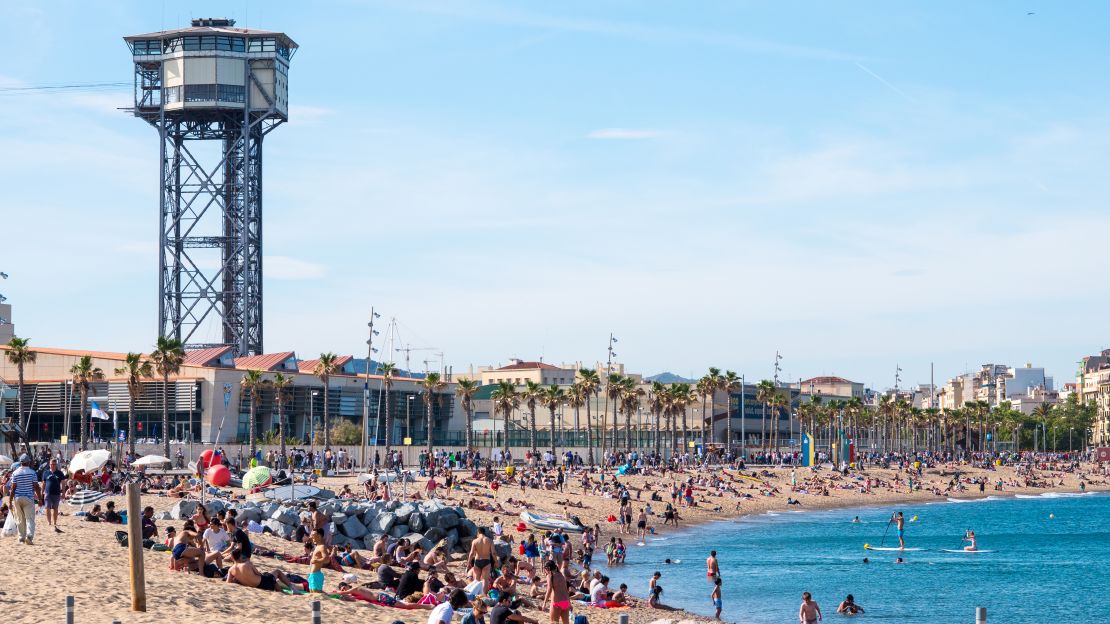
This beach is close to the center of action – just to the south of Barceloneta near the sail-shaped W Hotel – but it’s generally quiet enough to still hear the light shoosh of small, lapping waves over the bicycle bells ringing on the promenade.
Sant Sebastía is one of the oldest swimming areas in the city, and the Club Natació here began hosting dips for the elite in the early 20th century. That history, plus the convenience to the center of town, draws an older crowd and families in the morning. By the time the sun hits its afternoon peak, the crowd gives way to a more boisterous gathering.
The beach is also home to the Pukas Surf School, evidence that on days after a storm, surfers come to vie for modest waves. On calmer days paddleboarders and windsurfers dot the horizon. (Avenida Zurriola 24, 20002 San Sebastian; +34 943 320 068)
Be aware that it’s clothing-optional, so you’ll see your fair share of nude sunbathers who don’t care at all about hundreds of people walking within ogling distance.
In fact, Sant Sebastía has always been liberal and caused quite a stir when it became the first bathing area in the city to allow men and women to swim together.
Somorrostro
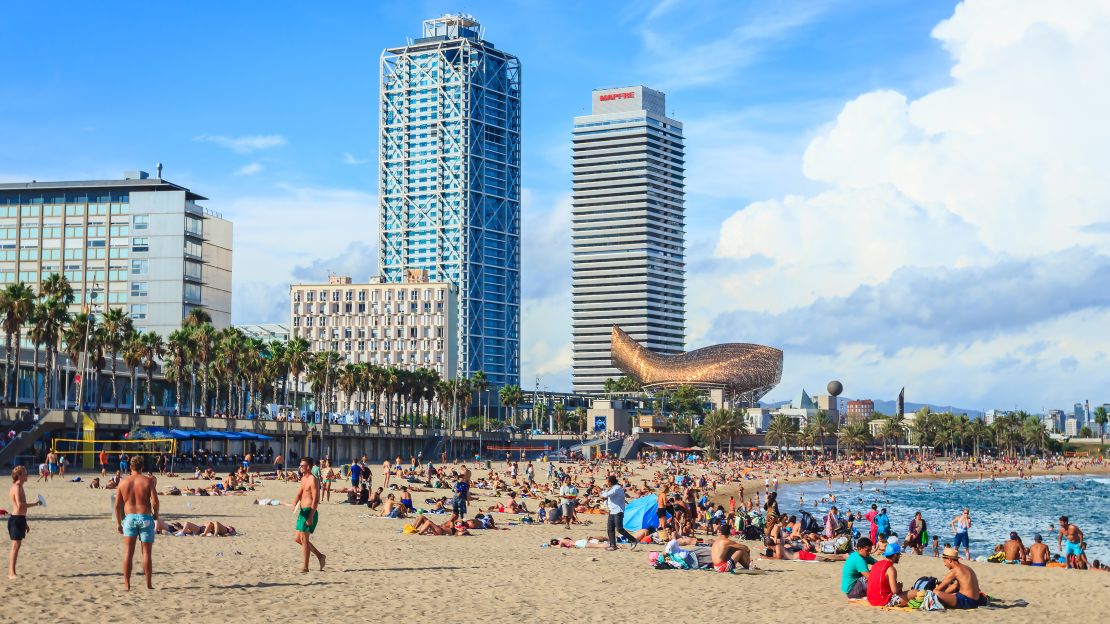
This area sits between the outdoor exercise pier that marks the north end of Barceloneta and the twin towers of the Port Olympic. Until the mid-20th century Sorromostro hosted a shantytown that housed up to 15,000 people, but now it’s home to the coastline’s fanciest restaurants.
A fashionable crowd lounges on plush sun chairs underneath Frank Gehry’s lacy, bronze fish statue, nibbling elevated takes on traditional tapas and sipping sangria (try it with sparkling cava instead of wine). Just make sure to put a shirt and shoes back on before trying to get in.
For those who prefer to pass on the pricey cocktails, there are still drink and ice-cream kiosks, and the marina at the north end of Somorrostro beach has a number of restaurants offering more bang for your buck.
There are a couple of fast-food chains and a number of reasonable Middle Eastern options to provide some variety to your Spanish vacation diet of cured ham, olives and fried croquettes.
Nova Icaria and Bogatell
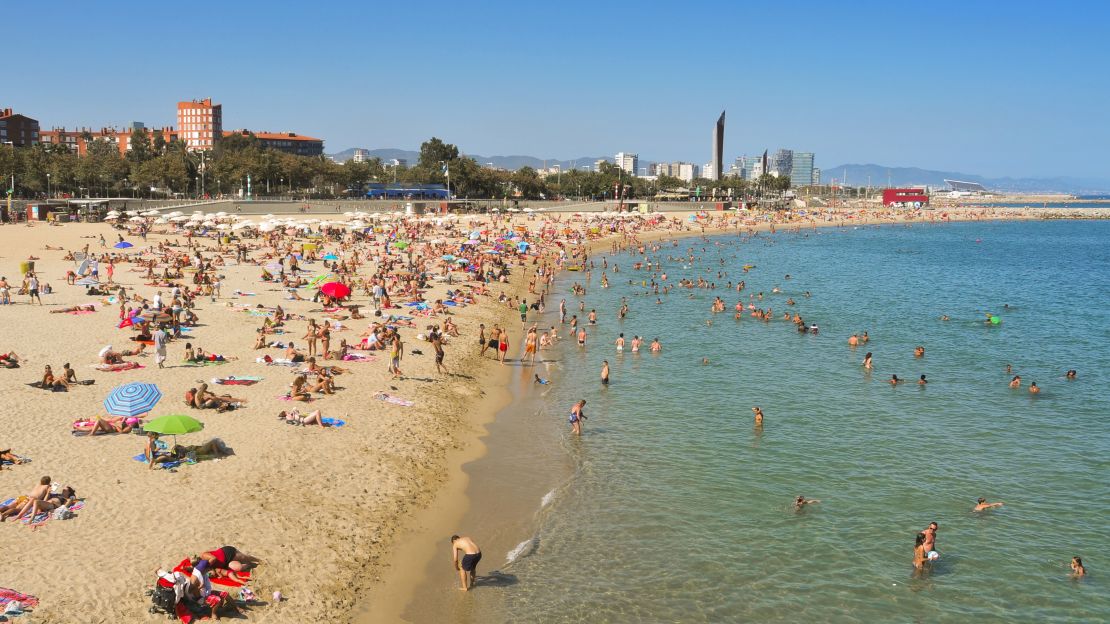
It’s hard to believe that these beaches were an industrial wasteland before the city tore up seaside train tracks ahead of the 1992 Olympics.
Sand was imported from Egypt, and a center of beach sports was born. Each summer, the city sets up dozens of volleyball courts along this stretch north of the Port Olímpic but some stay year-round at Nova Icaria. They’re free to use, so come early or be prepared to wait. On weekend mornings, you’ll also find lessons available.
The line of chiringuitos extends to both beaches, but they also host a handful of proper restaurants along the Passeig de Maritim, where local families come to share a paella on Sunday afternoons.
At the north end of Bogatell, the Nautica Base Barcelona offers lessons for windsurfing, kitesurfing and sailing plus kayaks and catamarans that shove off from a pier into open water, past all the swimmers. (Av. del Litoral, s/n, 08005 Barcelona; +34 932 21 04 32)
There’s also a no-frills cafe that’s good value compared to many of the other beachfront places.
The ease of access to two more Metro stops and the variety of activities make these a good option for families without a car, or for a vacationer looking for a more relaxed atmosphere than the packed beaches to the south.
Mar Bella
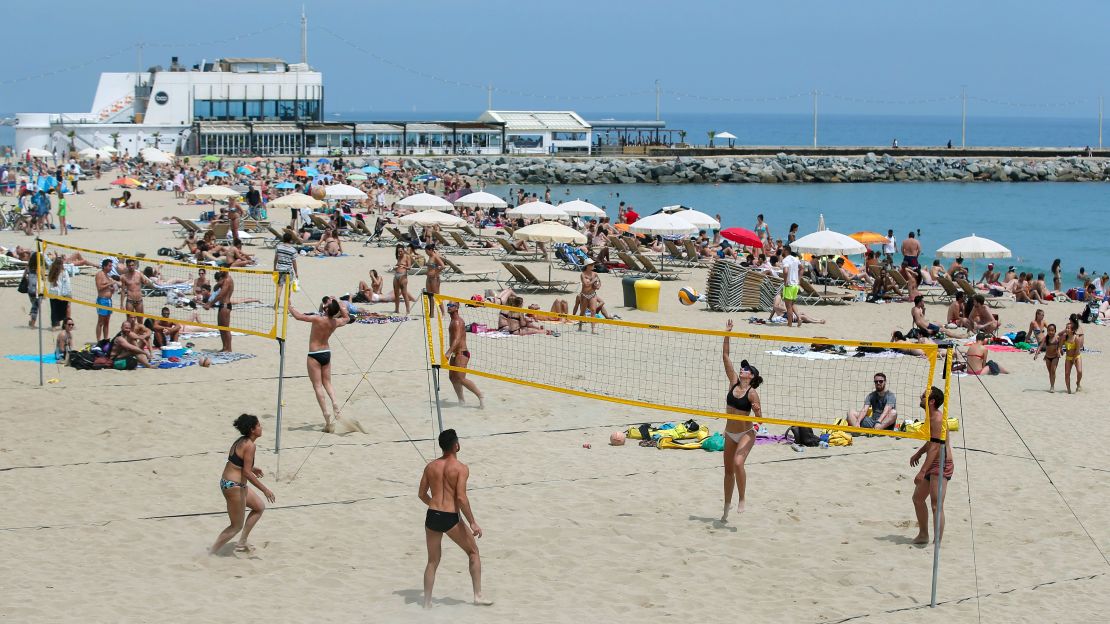
From Mar Bella and farther north, things tend to be even quieter, cleaner, and with fewer vendors walking the beach. Both Mar Bella and Nova Mar Bella, one beach north, have been designated as blue-flag beaches for their quality. They’re also less obviously attached to the city, though still well served by public transit.
Besides pristine sand and the cleanest segment of water in the city, Mar Bella also displays another example of the city’s liberal attitude. On one end of the beach is a rope pyramid for kids and a small playground with a slide; on the other is a nudist section.
Unlike at Sant Sebastía, a man-made hill separates the nude area of the beach from the pedestrian promenade, which runs next to a park where you can seek some midday shade. The park also has a network of skateboard ramps used mostly by kids on razor scooters, which is always fun for people-watching.
This beach also draws gay sun worshipers and a beach bar called Chiringuito BeGay opens here up every summer. But it’s a mixed crowd, so all are welcome. (Paseo Marítimo de la Mar Bella, s/n, 08005 Barcelona; +34 608 30 24 54)
Nova Mar Bella and Llevant
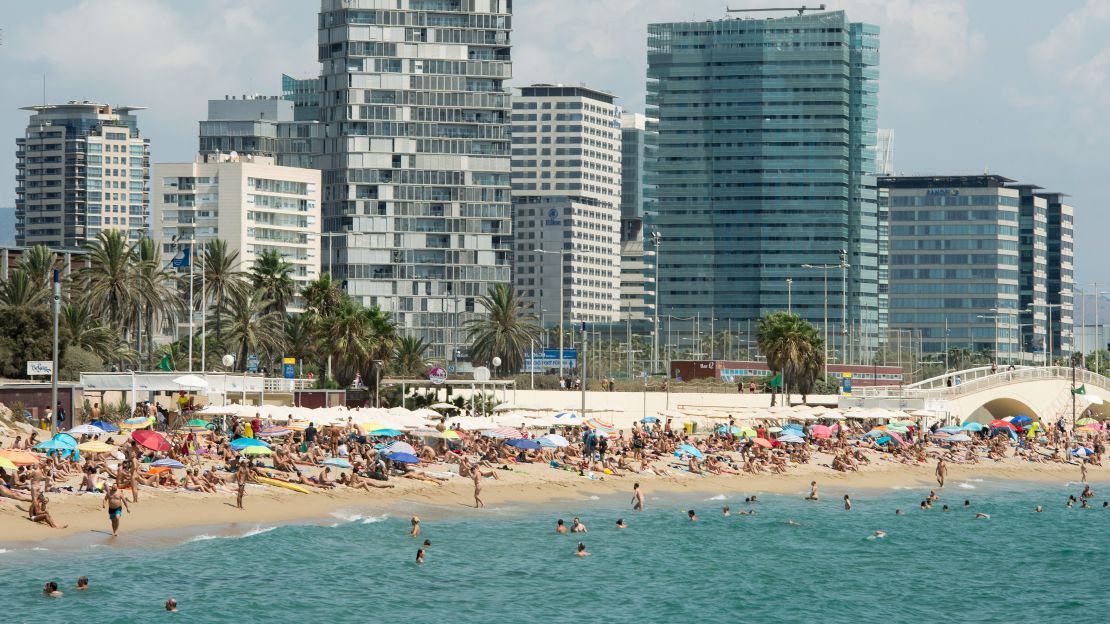
Amenities like restaurants become a little more sparse in these northernmost beaches, though there are still bathrooms and showers. But what is lacking in services is made up with parking. A 15-foot-high wall separates the beach from the car lots and the most modern towers of Barcelona’s skyline, so it’s still easy to focus on the clear Mediterranean.
Other than the ease of shuttling the kids to shore, other activities make it an ideal destination for a family with a car to spend a full day. In the morning you could hit up the Bosc Urbà, which is Catalan for urban forest, a covered adventure park in the Forum complex with zip lines, bungee cords and rope bridges. (Parc del Forum, s/n, 08019 Barcelona; +34 931 17 34 26)
A few blocks away from the sea, there’s the Museu Blau, a natural science museum that recently featured an exhibit on the Spinosaurus, “the lost giant of the Cretaceous.” (Plaza Leonardo da Vinci, 4-6, 08019 Barcelona; +34 932 56 60 02)
There are also play areas for kids, beach volleyball courts and clubs where senior citizens play dominoes or cards. A sand-free swimming area called Banys Forum sits just to the north, enclosed by piles of concrete blocks with steps that lead into the water.
Albert Stumm is a freelance travel and food writer based in Barcelona. You can find him on Instagram and Twitter @albertstumm.



















